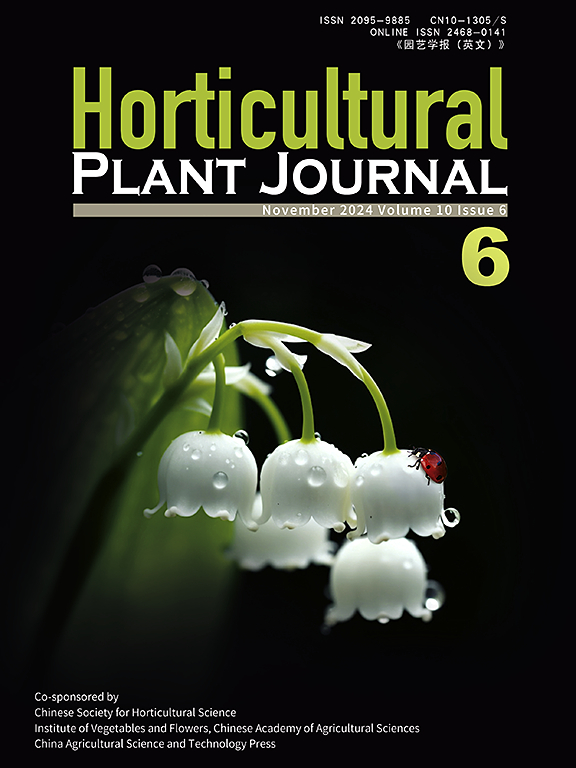CsCXEs 的生物化学特征:羧基酯酶促进了茶叶加工过程中绿色气味挥发物的生物合成
IF 5.7
1区 农林科学
Q1 HORTICULTURE
引用次数: 0
摘要
茶叶风味是茶叶香气和其他特征的综合体现。茶叶加工过程中挥发性气味化合物的形成取决于各种酶和非酶活动。(Z)-3-己烯醇被认为是绿色气味的主要来源,也是茶叶香气中最重要的成分,对整体香气有显著影响。然而,(Z)-3-己烯醇在茶叶加工过程中的生物合成和积累尚未得到全面分析。本研究通过 GC-MS 发现,不同时间的萎凋处理和不同程度的萎凋加摇动处理促进了绿茶气味中重要挥发性成分的积累,尤其是(Z)-3-己烯醇。RNA-seq和qRT-PCR结果表明,萎凋和萎凋加摇动处理提高了茶叶中(Z)-3-己烯醇相关基因的表达,包括合成途径1基因(CsLOX3、CsHPL1、CsADH4和CsAHD1)、合成途径2基因(CsGLU)和合成途径3基因(CsCXEs)。对关键气味物质和三个合成途径中重要基因的相关性分析表明,一些 CsCXEs 与绿色气味化合物呈正相关。体外酶活性结果显示,rCsCXE3(GWHTASIV011658)和rCsCXE6(GWHTASIV031480)对三种茶叶乙酸化合物[乙酸己酯、(E)-2-乙酸己酯和(Z)-3-乙酸己酯]具有水解活性,从而产生相应的醇类化合物。总之,茶叶加工过程中的萎凋和摇青处理促进了 CsCXE3 和 CsCXE6 的表达,从而提高了己烯醇化合物的产量。这些化合物对增加茶叶的绿色气味起着至关重要的作用。本文章由计算机程序翻译,如有差异,请以英文原文为准。
Biochemical characterization of CsCXEs: Carboxylesterase enhances the biosynthesis of green odor volatiles during tea processing
Tea flavor is a comprehensive representation of its aroma and other characteristics. The formation of volatile odor compounds during tea processing depends on a variety of enzymatic and non-enzymatic activities. (Z )-3-hexenol is considered the primary source of the green odor and is also the most important component in tea aroma, significantly affecting the overall aroma. However, the biosynthesis and accumulation of (Z )-3-hexenol during tea processing have not been fully analyzed. In this study, we found that withering treatment at different times and withering plus shaking treatment at different degrees promoted the accumulation of important volatile components of green tea odor, especially (Z )-3-hexenol by GC–MS. The RNA-seq and qRT-PCR results showed that withering and withering plus shaking treatments enhanced the expression of (Z )-3-hexenol-related genes in tea leaves, including synthetic pathway 1 genes (CsLOX3 , CsHPL1 , CsADH4 , and CsAHD1 ), synthetic pathway 2 genes (CsGLU ), and synthetic pathway 3 genes (CsCXEs ). Correlation analysis of the key odorants and important genes in the three synthetic pathways revealed that some CsCXEs were positively correlated with green odor compounds. The in vitro enzyme activity results showed that rCsCXE3 (GWHTASIV011658), and rCsCXE6 (GWHTASIV031480) exhibited hydrolytic activity against three tea acetate compounds [hexyl acetate, (E )-2-hexyl acetate, and (Z )-3-hexyl acetate], resulting in the production of corresponding alcohol compounds. In summary, withering and shaking treatment during tea processing promoted the expression of CsCXE3 and CsCXE6 , thereby enhancing the production of hexenol compounds. These compounds play a crucial role in increasing the green odor of tea.
求助全文
通过发布文献求助,成功后即可免费获取论文全文。
去求助
来源期刊

Horticultural Plant Journal
Environmental Science-Ecology
CiteScore
9.60
自引率
14.00%
发文量
293
审稿时长
33 weeks
期刊介绍:
Horticultural Plant Journal (HPJ) is an OPEN ACCESS international journal. HPJ publishes research related to all horticultural plants, including fruits, vegetables, ornamental plants, tea plants, and medicinal plants, etc. The journal covers all aspects of horticultural crop sciences, including germplasm resources, genetics and breeding, tillage and cultivation, physiology and biochemistry, ecology, genomics, biotechnology, plant protection, postharvest processing, etc. Article types include Original research papers, Reviews, and Short communications.
 求助内容:
求助内容: 应助结果提醒方式:
应助结果提醒方式:


